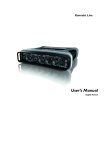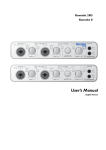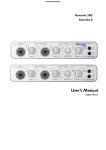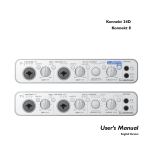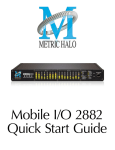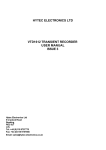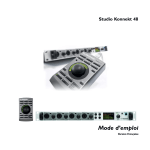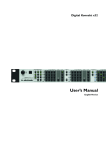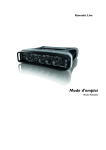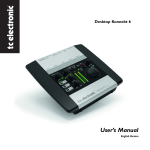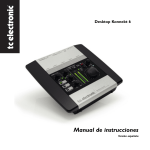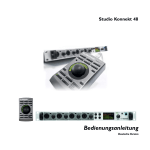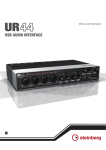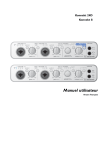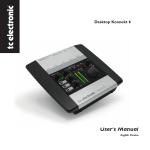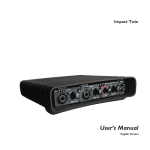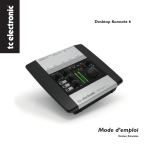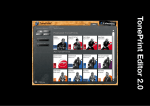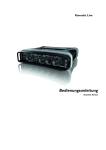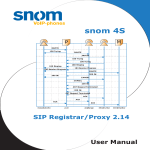Download User`s Manual - TC Electronic
Transcript
Studio Konnekt 48 User’s Manual English Version IMPORTANT SAFETY INSTRUCTIONS The lightning flash with an arrowhead symbol within an equilateral triangle is intended to alert the user to the presence of uninsulated “dangerous voltage” within the product's enclosure that may be of sufficient magnitude to constitute a risk of electric shock to persons. 1 2 3 4 5 6 7 8 9 10 11 12 13 14 Read these instructions. Keep these instructions. Heed all warnings. Follow all instructions. Do not use this apparatus near water. Clean only with dry cloth. Do not block any ventilation openings. Install in accordance with the manufacturer's instructions. Do not install near any heat sources such as radiators, heat registers, stoves, or other apparatus (including amplifiers) that produce heat. Do not defeat the safety purpose of the polarized or grounding-type plug. A polarized plug has two blades with one wider than the other. A grounding type plug has two blades and a third grounding prong. The wide blade or the third prong are provided for your safety. If the provided plug does not fit into your outlet, consult an electrician for replacement of the obsolete outlet. Protect the power cord from being walked on or pinched particularly at plugs, convenience receptacles, and the point where they exit from the apparatus. Only use attachments/accessories specified by the manufacturer. Use only with the cart, stand, tripod, bracket, or table specified by the manufacturer, or sold with the apparatus. When a cart is used, use caution when moving the cart/apparatus combination to avoid injury from tip-over. Unplug this apparatus during lightning storms or when unused for long periods of time. Refer all servicing to qualified service personnel. Servicing is required when the apparatus has been damaged in any way, such as cord or plug is damaged, liquid has been spilled or objects have fallen into the apparatus, the apparatus has been exposed to rain or moisture, does not operate normally, or has been dropped. The exclamation point within an equilateral triangle is intended to alert the user to the presence of important operating and maintenance (servicing) instructions in the literature accompanying the product. Warning! • • • • • To reduce the risk of fire or electric shock, do not expose this apparatus to rain or moisture and objects filled with liquids, such as vases, should not be placed on this apparatus. This apparatus must be earthed. Use a three wire grounding type line cord like the one supplied with the product. Be advised that different operating voltages require the use of different types of line cord and attachment plugs. Check the voltage in your area and use the correct type. See table below: Voltage Line plug according to standard 110-125V UL817 and CSA C22.2 no 42. 220-230V CEE 7 page VII, SR section 107-2-D1/IEC 83 page C4. 240V • • • • • BS 1363 of 1984. Specification for 13A fused plugs and switched and unswitched socket outlets. This equipment should be installed near the socket outlet and disconnection of the device should be easily accessible. To completely disconnect from AC mains, disconnect the power supply cord from the AC receptacle. The mains plug of the power supply shall remain readily operable. Do not install in a confined space. Do not open the unit – risk of electric shock inside. Caution: You are cautioned that any change or modifications not expressly approved in this manual could void your authority to operate this equipment. Service • • There are no user-serviceable parts inside. All service must be performed by qualified personnel. a EMC / EMI & CERTIFICATE OF CONFORMITY EMC/EMI This equipment has been tested and found to comply with the limits for a Class B Digital device, pursuant to part 15 of the FCC rules. These limits are designed to provide reasonable protection against harmful interference in residential installations. This equipment generates, uses and can radiate radio frequency energy and, if not installed and used in accordance with the instructions, may cause harmful interference to radio communications. However, there is no guarantee that interference will not occur in a particular installation. If this equipment does cause harmful interference to radio or television reception, which can be determined by turning the equipment off and on, the user is encouraged to try to correct the interference by one or more of the following measures: • • Reorient or relocate the receiving antenna. Increase the separation between the equipment and receiver. • Connect the equipment into an outlet on a circuit different from that to which the receiver is connected. • Consult the dealer or an experienced radio/TV technician for help. For Customers in Canada: This Class B digital apparatus complies with Canadian ICES-003. Cet appareil numérique de la classe B est conforme à la norme NMB-003 du Canada. b Certificate of Conformity TC Electronic A/S, Sindalsvej 34, 8240 Risskov, Denmark, hereby declares on own responsibility that the following product: Studio Konnekt 48 that is covered by this certificate and marked with CE-label conforms with following standards: EN 60065 Safety requirements for mains (IEC 60065) operated electronic and related apparatus for household and similar general use EN 55103-1 Product family standard for audio,video, audio-visual and entertainment lighting control apparatus for professional use. Part 1: Emission. EN 55103-2 Product family standard for audio, video, audio-visual and entertainment lighting control apparatus for professional use. Part 2: Immunity. With reference to regulations in following directives: 73/23/EEC, 89/336/EEC Issued in Risskov, September 2007 Mads Peter Lübeck Chief Executive Officer TABLE OF CONTENTS INTRODUCTION APPENDIX Safety instructions . . . . . . . . . . . . . . . . . . . . . .a EMC/EMI & Certificate of Conformity . . . . . . . .b Table of contents . . . . . . . . . . . . . . . . . . . . . . .3 Introduction . . . . . . . . . . . . . . . . . . . . . . . . . . . .4 Setup notes . . . . . . . . . . . . . . . . . . . . . . . . . . .5 Computer requirements . . . . . . . . . . . . . . . . . .5 ASIO channel names . . . . . . . . . . . . . . . . . . .66 Signal flow . . . . . . . . . . . . . . . . . . . . . . . . . . .67 FAQ . . . . . . . . . . . . . . . . . . . . . . . . . . . . . . . .68 Shortcut keys . . . . . . . . . . . . . . . . . . . . . . . . .68 DICE background . . . . . . . . . . . . . . . . . . . . . .68 Firmware update & Reset to default . . . . . . . .69 OVERVIEW Front panel overview . . . . . . . . . . . . . . . . . . . .6 Rear panel overview . . . . . . . . . . . . . . . . . . . . .8 CONTROL PANEL Mixer page . . . . . . . . . . . . . . . . . . . . . . . . . . .10 Preset handling . . . . . . . . . . . . . . . . . . . . . . .15 Setup page . . . . . . . . . . . . . . . . . . . . . . . . . . .16 Bass management . . . . . . . . . . . . . . . . . . . . .20 SETUP EXAMPLES Studio recording & monitoring . . . . . . . . . . . .22 Bass management & integration . . . . . . . . .24 Integrator . . . . . . . . . . . . . . . . . . . . . . . . . . . .26 Konnekt WDM driver . . . . . . . . . . . . . . . . . . .29 System settings . . . . . . . . . . . . . . . . . . . . . . .30 Studio Kontrol Remote . . . . . . . . . . . . . . . . . .34 Studio Kontrol Remote page . . . . . . . . . . . . .38 Fabrik C Studio . . . . . . . . . . . . . . . . . . . . . . . .40 Fabrik R Studio . . . . . . . . . . . . . . . . . . . . . . . .52 Preset Handling . . . . . . . . . . . . . . . . . . . . . . .58 ResFilter . . . . . . . . . . . . . . . . . . . . . . . . . . . . .60 Tuner . . . . . . . . . . . . . . . . . . . . . . . . . . . . . . .64 TC Electronic, Sindalsvej 34, DK-8240 Risskov – [email protected] English Version Manual revision 1.0 3 INTRODUCTION SETUP NOTES Studio Konnekt 48 offers a comprehensive array of professional features that make recording, mixing and monitoring a breeze. All essential recording tools are in one box including world-class DSP effects, a wealth of I/O options, speaker management and many other powerful tools to take your recordings to the next level. Extensive I/O section with IMPACT II™ preamps • 4 Impact II™ mic preamps • 12 analog inputs, 12 analog outputs simultaneously • High resolution input meter • 96 kHz ADAT (8 channels SMUX), word clock and S/PDIF • 24/24 channels simultaneously to/from DAW • Digitally controlled analog main XLR outputs • Dual headphone outs with individual level control and source 24/8 channel digital mixer with double precision summing • Flexible 24/8 DSP mixer with total recall and DSP effects insert points • No compromise routing for all outputs • 48-bit double precision summing on all mix busses with 56-bit internal processing • Talkback with selectable dim setting and listen back feature • Aux send busses with flexible output routing Speaker management based on AIR™ technology • Full featured bass management section based on AIR™ - Speaker Management Technology • Full support for surround systems • Individual speaker level and delay settings in 0.1 steps • Selectable frequency crossover points • Support for 3 speaker systems, individually configurable, selectable from the remote World-class DSP effects • 4 simultaneous 4-band EQ, multiband compression channel strip and mastering effects based on TC System 6000 algorithms • No compromise built-in reverb based on TC Electronic Reverb 4000 technology • All plug-ins VST and AU compatible • Intuitive guitar tuner • ResFilter plug-in • Assimilator Konnekt plug-in • Hardware effects Integrator plug-in Desktop remote control with integrated talkback microphone (optional) • Full mixer at your hand • Built-in talkback mic • High resolution LED light ring • Compact design More • DICE II JetPLL™ jitter elimination technology • Clock recovery • Expandable with all other Konnekt interfaces thru TC Near Should this manual leave any of your questions unanswered, please use the TC Support service, which you can access via our website www.tcelectronic.com. Over a period of time, we will collect the most frequently asked questions and update the manual accordingly. Manual updates are available for download on our website in PDF format. The current manual revision number is found at the bottom of page 3. 4 Unpacking • Open the box from the top and remove cabling. • Lift out Styrofoam insert, then using both hands lift out Studio Konnekt 48. • Remove plastic bag from Konnekt. • Inspect your Studio Konnekt 48 for signs of transit damage. • In the unlikely event of this having occurred, inform the carrier and the supplier. • Keep all the packaging if damage has occurred, as this will show evidence of excessive handling force. • It is also a good idea to keep the packaging if possible for future transportation. Check contents The package should contain the following items: • Studio Konnekt 48 audio interface • Studio Kontrol 48 remote and cable (optional) • FireWire cable • CD with software etc. • Safety Instructions • Quick Start Guide Computer Requirements Mac OS X 10.4 Tiger or 10.5 Leopard • PowerPC (1 GHz or faster) or Intel CPU • 512 MB RAM • FireWire (IEEE 1394) port* • OS X 10.4.1 or 10.5 This would typically be on an installed FireWire PCI card. Note that such a FireWire PCI card typically has 3 ports but these also operate on a single bus. Software installation • Be sure that you have the latest software. Download the latest software from www.tcelectronic.com/software • We recommend installing the software before connecting the Studio Konnekt 48. • Refer to the Konnekt Installation Guide supplied in the package and on the Konnekt CD. • If you are familiar with software installation procedures in general you may simply insert the accompanying CD-ROM in your computer’s CD drive and follow the instructions. TC Near control panel If Konnekt drivers are installed correctly you are able to open the TCNear control panel. On Windows computers: Press: Start/Programs/TC Electronic/TC Near The TC Near can also be accessed via the Windows Control panel. On Mac computers: /Applications/TC Near You may also start the application from System Preferences. Windows XP SP2 or Vista x32 • Pentium 4, 1.6 GHz or faster • 512 MB RAM • FireWire (IEEE 1394) port* • Windows XP or Vista 32 bit * We recommend running Konnekt units on a dedicated FireWire bus. If your computer has one or more FireWire connections on the chassis they will typically run on the same FireWire bus. You may connect the Konnekt to one of these. If you intend to run more FireWire devices simultaneously, such as e.g. an external hard drive, we recommend running this device on a separate bus. 5 FRONT PANEL FRONT PANEL 6 channel 1 preamp channel 2 preamp OFF -20dB TM -20dB max gain trim TM -20dB max gain trim TM phones 2 master level ADAT SPDIF 1-8 1-2 -20dB TOS 1-2 3-4 MIDI IN OUT PAD min mic/inst input IMPACT II technology phones 1 OFF PAD min mic/inst input IMPACT II technology channel 4 preamp OFF PAD min mic/inst input IMPACT II technology channel 3 preamp OFF PAD max gain trim min mic/inst input TM IMPACT II technology max gain trim 1 (ch3-4) (ch11-12) 2 3 4 5/6 O -3 -6 -12 -24 -40 7/8 9/10 11/12 dB ADAT SPDIF 1-8 1-2 power TOS 1-2 3-4 MIDI IN OUT OFF ON min max output FireWire 48V valid FireWire studiokonnekt 48 1 2 3 4 5/6 O -3 -6 -12 -24 -40 7/8 9/10 11/12 dB Meters 1-4: Indicate the signal level present on the four inputs on the front panel. 1 Mic/Inst ch1-4 on combo XLR/Jack Combo XLR/jack inputs. Both XLR and 1/4 inch jack can be used with this connector type. 2 The XLR connection (balanced) Connect a microphone and you connect directly to the input of the IMPACT ™ mic preamps. 3 - - For condenser microphones phantom power must always be activated. (see also #10 on the following page). It is generally no problem to use dynamic microphones in combination with phantom power. The Input LEDs on meters 1-4 indicate the level of the input signal. If the red O dB LED (overload) is lit, your signal is too “hot” and you should reduce the input gain using the GAIN TRIM potentiometer and/or the the PAD/-20 dB switch for that channel. The 1/4 jack connection preamp OFF -20dB 4 Pad selector The PAD selector can attenuate the input sensitivity by 20 dB. If you cannot attenuate the signal sufficiently using the GAIN/TRIM knob you should use the -20 dB position. This is typical when connecting line-level instruments. Gain/Trim Use this control to set the appropriate input level. (see previous paragraph). Phones 1/Phones 2 Individual level control for phones output 1 and 2. Meters 5/6, 7/8, 9/10 & 11/12: Indicates the signal preset on the line inputs on the rear panel. The meters always indicate the loudest/hottest signal of a channel pair. Orange LEDs for ADAT, S/PDIF & TOS: The orange LEDs refer to the lock state of the digital channels. Lock is acheived when the orange LEDs are lit. Orange LEDs for MIDI: LEDs for indication of MIDI In/Out. 7 5 Headphones connection Two set of headphones may be connected for monitoring. Each headphones output has its own level control. It is also possible to set up an individual mix for each headphones output via aux 1 on the mixer page. Please refer to the description of the mixer page. 6 FireWire/Power LED indicator When Studio Konnekt 48 is hooked up via FireWire, the blue LED in the right side of the display can indicate the following: Steady lit: Connected to FireWire Flashing: Uploading firmware, hardware error or FireWire communication error. Off: The Studio Konnekt 48 has no connection to the driver, maybe because the driver is not installed. PAD The 1/4 “jack part” of the connector is a high quality unbalanced Hi-Z circuit that is designed especially for direct connection of a passive guitar pick-up system (e.g. Strat-type) directly. If you want to connect balanced equipment using TRS jacks you should connect via the line inputs on the rear panel. lit, the current position of the knob matches the actual output level. Meters Warning! Excessive sound pressure from earphones and headphones can cause hearing loss. 8 9 Output Level control Sets the output level and overrules the level previously set by the Studio Kontrol remote. 10 Phantom Power +48V The XLR part of the Combo XLR/Jack connections features +48V phantom power when this switch is set to on. Phantom power is used to power line-drivers and condenser microphones. There are three main types of microphones Condenser microphone - phantom power required except for some models that use proprietary power supplies or built-in batteries. Please check the microphone's manufacturer specifications for details. Electrodynamic microphone - phantom power is not required, but does not harm the microphone. Ribbon microphones - phantom power could damage the microphone. Seek advice and documentation from the manufacturer of the microphone! Only the condenser type requires phantom power. It is, however, no problem combining a condenser microphone in e.g. ch. 1, with a standard electrodynamic microphone (such as e.g. a Shure SM57) in ch. 2. Nor is it any problem to activate phantom power and use a condenser microphone to one input and connect a guitar using a 1/4 jack one of the other inputs, as phantom power only concerns the XLR connections. Valid LED The master output level can be set using either the physical OUTPUT knob, via the Studio Kontrol remote or via the TC Near software mixer. If the green LED is 7 REAR PANEL REAR PANEL 9 CAUTION in 100-240VAC~ 50-60Hz, 25W WCK out in spdif out WARNING SERIAL NO. in opto out tos 3-4 RISK OF ELECTRIC SHOCK DO NOT OPEN MIDI input main stereo outputs IN output adat 96k TO REDUCE THE RISK OF FIRE OR ELECTRIC SHOCK DO NOT EXPOSE THIS EQUIPMENT TO RAIN OR MOISTURE AVIS: RISQUE DE CHOC ELECTRIQUE-NE PAS OUVRIR. DESIGNED AND DEVELOPED BY TC ELECTRONIC 12 11 10 9 8 7 6 5 adat main R C US UL60065 EN/IEC 60065 OUT tos 1-2 remote Remote RJ-45 connector for the Studio Kontrol remote (optional). ch2|right firewire ch1|left right left right left right left 10 FireWire connectors IEEE 1394 connectors for connecting to a computer and/or linking multiple Konnekt units. right left Before plugging the firewire connectors, make sure that plugs are positioned correctly. 1 Power In Mains power in. Studio Konnekt 48 uses a switchmode power-supply that accepts from 100 to 240VAC. 2 Word Clock In If you want to sync to an external word clock generator, connect it to WCK In using BNC connectors and select “Word Clock” as sync source on the System Settings page. 3 Word Clock Out Due to the DICE II chip, Studio Konnekt 48 can act as an excellent master clock generator for you setup. Connect via standard BNC plugs. Beware that the Word Clock signal is not standardized. Some Word Clock receivers are known to fail when the peak-to-peak signal exceeds 3 Volt, and others are known to require at least 4 Volt, making it impossible to design a Word Clock driver guaranteed to operate with all receivers. Studio Konnekt 48 sends 1.7V PP. 4 8 S/PDIF In/Out Two channel, 24 bit 96 kHz digital in/out on S/PDIF. In addition to standard I/O it is possible to insert e.g. an external digital effects unit and use this as a send effect. (see setup examples) 5 - - - ADAT/Toslink I/O connectors The optical connections carry either Toslink (optical S/PDIF) or ADAT signal. ADAT: At normal sample rate, 8 channels of ADAT is carried on a single lightpipe. Use the MAIN connector. At double sample rate, 8 channels of ADAT is distributed on 2 lightpipe connectors. Use both the MAIN and the 96 kHz connections. Toslink: Studio Konnekt 48 handles up to 4 input channels and 4 output channels of optical S/PDIF via Toslink. 6 MIDI In/Out Standard MIDI in/out. When Studio Konnekt 48 is used in stand-alone mode, MIDI out always acts as MIDI thru. 7 Main Outputs Digitally controlled true analog main outputs on balanced XLR. Pin 1 Ground Pin 2 Hot Pin 3 Cold 8 In/Out - additional channels Input and outputs for channels 5 to 12 on balanced 1/4” jacks. The sensitivity for the line inputs can be set to -10 dBv or +4 dBu via the TC Near mixer page. 9 CONTROL PANEL - MIXER PAGE CONTROL PANEL - MIXER PAGE 1 The Konnekt select tabs Use the select tabs to switch between the Konnekt units in your setup and the System Settings page. 2 Page tabs Press to navigate between the mixer, setup, effects and tuner pages for the selected Konnekt unit. 3 Add Channel 4 Auto shrink Unlike the “Remove Channel” function that allows you to completely remove an input channel that you no longer use, the Auto shrink function keeps all channels in the mixer, but collapses the graphics so that idle channels take up only a minimum of space. Example: In this example no cables are attached to the Studio Konnekt 48’s inputs and by pressing the AUTO SHRINK button we get this view: To keep an easy overview, not all channels are included in the default mixer layout. You may add any idle channel or channel pair via the Add Channel drop down menu. Channels that are already displayed in the mixer are “grayed out”. Channels that you can add are “solid”. Max I/O mixer channels are 24 in / 8 out. Removing a channel Just as some channels can be added, the same channels can also be removed from the mixer when not used. Channels that can be removed have a small crossed square in the upper right corner. De-click this field to remove the channel from the mixer. 5 Channel type Indicates the channel type. Front panel, Digital, DAW, FireWire Output, Line etc. 6 Ch1-4 auto-sensing input Channels 1-4 connections on the front panel are autosensing. They automatically detect whether you have connected an XLR (microphone) or 1/4” jack (instrument), and this is displayed graphically. See also “Auto shrink”. 10 11 CONTROL PANEL - MIXER PAGE These are the options Nothing connected 7 Mic/XLR Inst./jack Channel name - editable This is the name of the mixer channel. Click once on the name using the mouse to edit the name. All Channels 8 9 Input Level meters & +4 dBu/-10 dBv sensitivity The meters indicate the level of the signal present on the input channels. Best signal to noise ratio is achieved when the input signal only occasionally peaks at “0”. Adjust the level on the sending device while watching the meters. You can toggle between a -10 dBv/+4 dBu sensitivity for line input channels by pressing: Clip LED (RED) When the Clip LED is lit the signal is too hot. Reduce the level on the sending device to compensate. CONTROL PANEL - MIXER PAGE 11 Sends Each channel has three sends. One for the Fabrik R reverb and one for each of the two AUX sends. Each send can be set as a pre or post fader send. The routing of the sends is set up on the Setup page. Example: Linked The recording artist is typically placed in a recording room wearing headphones. The Talkback function allows you to communicate to the performer either via the small built in microphone located in the Studio Kontrol remote or via a microphone connected to Mic Input #4 or via Line In 12. Unlinked 12 Pan/Balance Fader for for left/right panning. Press Ctrl+Shift and left mouse button to center. Selecting talkback microphone The talkback microphone in the Studio Kontrol is selected per default. 13 Mute/Solo Press M to mute the channel output and S for soloing this channel. 14 Channel Fader Fader for the output of the channel. 15 Fader assign - Studio remote control symbol Some channels and functions are by default assigned to the Studio Kontrol remote. However, any channel added with the “Add Channel” function will appear with the remote control symbol. By pressing this symbol you are allowed to assign this channel to remote buttons 1-6 when the remote is in shift mode. Press the remote symbol to access the drop down menu and select between Remote Button 1 to 6. To change to either mic preamp #4 or line input 12 first close the talkback channel. • Then press ADD CHANNEL and select talkback channel under “talkback”. 17 Monitor mix on/off Tick of this box if you do not want to use the TC Near direct monitor feature. Output section 18 Talkback function Talkback microphone P1 P2 P3 MIC PROG (P1-P3) 10 Channel inserts Via the small drop down menu just below the channel meter you can insert one of the two Fabrik C channel strips or none. 16 Channel pair link/unlink Press to link/unlink channels pairs. (see example on the following page) PANEL M.MIX AUX1 EFFECT AUX2 TALK TUNER Talkback button 12 • It is only possible to select channels that currently are not in use. 13 CONTROL PANEL - MIXER PAGE Let us take a closer look at the Talkback mixer-channel Channel naming and channel input metering is described previously. CONTROL PANEL - MIXER PAGE Click the “L” on the channels you want to feed to the outputs when talkback is active. Notice that the listen-back function overrides the dim function in order to be able to communicate with the recording musicians. Fabrik C studio - even on talkback Even on the talkback channel you can insert one of the Fabrik C compressors if you like. 20 Master Level Channel Adjust master level using the fader or the big volume knob on the remote (if assigned). Press DIM for dimming function. Meters indicate the current master level. 19 AUX Channels Dim level When activating the talkback function you most likely want to attenuate the mix level in the performer’s headphones. The Dim Level knob sets this level. The dim level can never be set higher than the normal level.* This is the Fabrik R return level. Press “M” to mute the Fabrik R return. Talkback routing The AUX sends are typically used for setting individual mix levels on the two headphone outputs. The AUX 1, AUX 2 and MAIN buttons determine to which outputs the talkback signal should be sent. Talk button Press the TALK button on the Studio Kontrol Remote or on the mixer. * Listen-back function Per default all output channels are muted when talkback is activated. It is, however, possible to keep feeding selected channels to the outputs, even when the talkback is invoked. For this we use the “Listen-back” function. Press TALK and you will see an “L” button appearing just below the MUTE “M” and SOLO “S” buttons on each channel. 14 Even on the AUX channels you are allowed to insert one of the Fabrik C Studio compressors. Assuming you use the AUX channels to set up one or two mixes for the headphone sets used by the recording artists, you may want to hear what you are currently sending to the AUX channels in the control room main monitors. Press “TO MAIN” to send to the AUX send to the main mix. 15 SETUP PAGE SETUP PAGE Input section Overview of the input channels. Idle inputs are grayed out. If a device is connected to an input the icon will display this. Example: Nothing connected 1 XLR device connected Mic Ch1-4 Channels 1-4 connections on the front panel are autosensing. They automatically detect whether you have connected an XLR (microphone) or 1/4” jack (instrument), and display this graphically. 4 Nominal Sample Rate Depending on the selected sample rate there are few restrictions with regards to the plug-ins. These are the options Nothing connected 3 Sync Source See the options in the illustration above. Studio Konnekt 48 will attempt to lock to the selected sync source. A steady orange LED above the meter for the relevant format indicates “lock”. A flashing LED indicates “no lock”. Mic/XLR Inst./jack Optical Format 2 Optical Input Format Select between ADAT or TOS. Stand-Alone Clock Settings To apply the "stand-alone clock settings": - power off the unit - disconnect firewire cable form unit - switch on the unit again 16 5 Options are: 44.1 kHz & 48 kHz Both Fabrik R Studio and two Fabrik C Studio are available 88.2 kHz & 96 kHz Fabrik R Studio and Fabrik C Studio are available 176,4 kHz & 192 kHz Fabrik R Studio and Fabrik C Studio are not available File The output section offers numerous choices of configuration and this section therefore has its own preset menu. Presets contain all the parameters in the output section. Load and Save files via this menu. 17 SETUP PAGE Routing Channels to Outputs Introduction - basics The main purpose of the output section is routing of the physical, DAW and FireWire input channels to the physical outputs. Starting from left going to right we have the: - the Source select that allows you to select the input you intend to route SETUP PAGE 6 Link button This button allows you to link/unlink channel pairs. DAW In this section you route the outputs of your DAW. Example: Typically, you would prefer having main outputs linked, but you may unlink main L and main R if individual delay or trim is needed. Speaker Sets Three speaker setups can be setup and switching between the sets is easy. The speaker setups A, B and C can be individually labeled according to your specific application. 8 Linked Speaker or Line level ? In the speaker section you select whether the signal is routed to a speaker or directly to a line output at max level. If this box is checked the level can be controlled by the master level of the remote control. If not, line is sent to outputs regardless of the master level setting. Unlinked - the option of routing source signal to any of the three speaker sets A, B, C and furthermore setting individual trim and delay for each source 7 - giving the outputs personal labels Source select Via the source select drop down menu you select the signal you are about to route. The options are: DSP The DSP outputs are: Main, AUX1, AUX 2 outputs and Fabrik R sends. The AUX outputs are typically used for headphones. IMPORTANT ! If a source signal is NOT assigned to a speaker set, you can check “DIRECT” and thus route the signal directly to the mains out at FULL VOLUME. If you e.g. have active monitors connected to the outputs and these set at full volume, then sending a signal, also at full volume, may damage the speakers. A pop-up dialog box will ask you to reconsider before sending the un-attennuated signal to outputs. Physical: These are the physical inputs on Studio Konnekt 48. .....let us take a look at each element of the Output section in detail. 9 18 Assigned to Indicates which speaker set or sets the source is assigned to. 19 SETUP PAGE SETUP PAGE outputs. 10 Speaker sets The speaker sets can be labeled individually. Simply click in the text field and enter a name of your choice. Example: Without Bass Management Example: With Bass Management 11 Trim Range: -20 dB to 0 dB Individual trim levels for each channel. 12 DLY Range: 0 to 30 ms Perfect listening conditions and placement of speakers according to an ITU 775 circle are not always possible. This delay parameter allows for individual alignment of speakers. 13 Output label The physical outputs have fixed names according to the labels on the rear panel. However, you can also add an additional personal label to these channel 20 - main channels must be assigned: - for bass management of the main channels to be active, mark the bass management-box Bass management The bass management system is designed to subtract the bass contents of all main channels and reproduce this by the use of a subwoofer and is easily set up with the Studio Konnekt 48. Assigning an output to a speaker set With no bass management an output is assigned directly to a speaker set by checking the ASSIGN check box for the output. However, when bass management is used you must set main speakers to “main” and sub to “sub”. 14 Bass Management For bass management to be active a few conditions must be setup: The LFE Channel LFE is short for Low Frequency Enhancement or Low Frequency Effects, the first being the original name but the second being the most correct with regards to its application. High-Pass The high-pass filter filters the low-end frequencies from the main channels above the x-over frequency and according to the high-pass options. - Let us take at look at the components and how to set up bass management using the Studio Konnekt 48. The Subwoofer A subwoofer is a monitor that reproduces low frequencies. The purpose is to take over from the main monitor(s) as frequencies approach the lower end of the monitors frequency range. Depending on the performance and size of the main monitors the used threshold frequency between main monitors an sub, may vary from 80 to 120 Hz. From psycho-acoustics we know that there is no directional information in audio signals below approximately 120 Hz. Hence the advantage of placing the subwoofer in a position where the best distribution is achieved. 16 + 17 High Pass & Low Pass The high/low pass filters filtrate the signal before distribution to main and sub-channels. The high-pass filter is typically used when relatively small main monitors are used. The performance of such small main monitors will improve significantly, when they don’t have to reproduce very low frequency signals. - a subwoofer is connected to “line out 8” and thus any LFE channel should be routed to this output by setting Assign to “Sub”. - Low-Pass The low-pass filter filtrates the high-end frequencies from the signal below the x-over frequency according to the low-pass options. - 15 X-OVER Sets the X-over frequency for the main channels to determine the frequency where the main channel signal is split. Frequencies below this point is routed to the sub channel (line out 8). “off” - no high-pass filter “12 dB/octave” for a 12 dB slope above the Xover point “24 dB/octave” for a 12 dB slope above the Xover point - “12 dB/octave” for a 12 dB slope below the Xover point “24 dB/octave” for a 24 dB slope below the Xover point 18 Levels Individual level adjustment for the LFE channel and the extracted signal below the X-over frequency. It is also referred to as the “.1”-channel, which indicates that the frequency range of this channel is only a fraction of the other channels in a multi-channel setup. The actual frequency range is 20 Hz to 120 Hz. 21 SETUP EXAMPLES - STUDIO RECORDING & MONITORING SETUP EXAMPLES - STUDIO RECORDING & MONITORING 5.1 SPEAKER SET - ACTIVE L C R SUB MAIN SPEAKERS - ACTIVE LS RS Features used in this setup: • 4 mic preamps and 4 line inputs for instruments and microphones • Easy switching between three sets of speakers including a 5.1 setup • Two separate sends for monitoring on headphones via AUX 1 and AUX 2 sends on the TC Near mixer page • Computer with TC Near control panel and DAW application • Studio Konnekt 48 as MIDI interface • Instruments and microphones connected via IMPACT IITM preamps. For more inputs, connect a pre-amp with ADAT interface to the ADAT inputs. DAW COMPUTER WITH FIREWIRE MAIN R MAIN L channel 2 preamp OFF -20dB -20dB max TM max gain trim USER 1 MIC2 USER 2 SPDIF CH5/6 USER 4 CH7/8 USER 5 DAW P1 P2 USER 3 USER 6 P3 MIC PROG (P1-P3) PANEL M.MIX AUX1 MASTER A EFFECT AUX2 CH on/off B TALK SHIFT TUNER C TM max gain trim MIC MIC BASS phones 1 phones 2 (ch3-4) (ch11-12) master level ADAT SPDIF 1-8 1-2 -20dB min mic/inst input TM IMPACT II technology TOS 1-2 3-4 MIDI IN OUT 1 2 3 4 Speaker set C - “Lo-Fi” OFF ON min 5/6 7/8 9/10 11/12 dB max output OUT IN Speaker set B - Surround LINE OUT 10 - RS power 48V valid FireWire O -3 -6 -12 -24 -40 max gain trim Speaker set A - Main speakers with bass management AMP studiokonnekt 48 IN LINE OUT 11 - L LINE OUT 12 - R OUT KEYBOARD STUDIO KONTROL GUITAR OFF PAD min mic/inst input IMPACT II technology studiokontrol MIC1 -20dB PAD min mic/inst input IMPACT II technology LINE IN 5+6 gain trim channel 4 preamp OFF PAD min TM channel 3 preamp OFF PAD mic/inst input IMPACT II technology MIDI channel 1 preamp LINE IN 7+8 FIREWIRE CAT 5 “LO-FI” SPEAKERS LINE OUT 5 - L LINE OUT 7 - C LINE OUT 6 - R LINE OUT 9 - LS LINE OUT 8 - LFE MIDI THRU KEYBOARD 22 23 SETUP EXAMPLES - BASS MANAGEMENT & INTEGRATION ACTIVE SPEAKERS RIGHT LEFT SETUP EXAMPLES - BASS MANAGEMENT & INTEGRATION Features in this setup • One stereo set of active speakers and one active Sub. The sub is fed with both the LFE channel signal and lo-freq signal from the main channels via bass management. • Two separate sends for monitoring on headphones via AUX 1 and AUX 2 sends on the TC Near mixer page • Computer with TC Near control panel and DAW application • Integrated external digital reverb via S/PDIF and the Integrator plug-in* • Integrated external analog filter via analog line I/O SUB DAW COMPUTER WITH FIREWIRE * Please refer to the instructions for the Integrator plug in on the following pages. MAIN L LINE 8 MAIN R FIREWIRE channel 1 preamp USER 1 MIC2 USER 2 SPDIF CH5/6 USER 4 CH7/8 USER 5 DAW AUX2 TALK USER 3 (P1-P3) MASTER A EFFECT -20dB CH on/off B SHIFT CAT 5 -20dB channel 4 preamp OFF PAD min mic/inst input TM IMPACT II technology max gain trim -20dB OFF PAD min mic/inst input TM IMPACT II technology max gain trim phones 1 phones 2 (ch3-4) (ch11-12) master level ADAT SPDIF 1-8 1-2 -20dB TOS 1-2 3-4 MIDI IN OUT PAD min mic/inst input TM IMPACT II technology max gain trim min mic/inst input TM IMPACT II technology 1 2 3 4 5/6 7/8 9/10 11/12 dB power 48V valid FireWire O -3 -6 -12 -24 -40 max gain trim OFF ON min max output studiokonnekt 48 • Select DAW Line Out 8 as source and assign this channel as “SUB”. • We have set a typical X-over frequency of 95 Hz. Low-pass is set to 24 dB/oct and High-pass to off. TUNER C SPDIF STUDIO CONTROL REVERB 4000 ANALOG FILTER 24 channel 3 preamp OFF PAD USER 6 P3 PROG AUX1 LINE 5 OUT P2 MIC IN LINE 5 IN P1 PANEL M.MIX channel 2 preamp OFF studiokontrol MIC1 Setting up • Select DAW Main Out 1+2 as source. Set speaker to “on” and assign to main. OUT 25 INTEGRATOR The Integrator plug-in for Studio Konnekt 48 makes integration of external hardware into your DAW environment seamless. Integrator offers a “plug-in” audio routing representation of your external digital effects processors and operates as a normal VST/AU plug-in. The Integrator plug-in can be inserted on any track, utilizing external effects as send or insert effects on any track or bus in your host application. INTEGRATOR Installation The Integrator plug-in is automatically installed along with the TC Near control panel. Parameters 1 Device Your setup may include several Konnekt units. Select the Konnekt unit to which you are about to integrate an external effect. 2 1st audio channel Your DAW detects audio channels on the Studio Konnekt 48 and labels these automatically. If you insert Integrator on a mono track it will open as a mono plug-in. On a stereo track it will open as a stereo plug-in. In stereo you will select channels by selecting the only first of the two. In the illustration on the previous page, main out 1/2 is selected even though the label says “main out 1”. 3 Calibrate Integrating external digital devices will introduce a short latency, but your host application can be set up to compensate for this using the Integrator calibrate function. 4 Test & Auto To verify that all cables to external units are properly connected, a pink noise test signal can be sent to left/right channels. Use L or R to send to left/right channels individually. You may also press AUTO. Then Integrator will send a pink noise signal that alternates between Left and Right channels. To prevent sending a test signal at max level (0 dB) to the selected “1st audio channel” the test signal level will automatically be turned down when pressing L, R or AUTO. However, you may change the test signal level by grabbing the yellow triangle and moving it up/down. The set level for this instance of the Integrator will be remembered. 5/6 Send/Return levels By moving the two yellow triangles next to the Send and Return meters you can set the Integrators send/return levels. Adjust these according to the I/O levels on the sending device. Meter indications should be as close to 0 dB as possible without overloading. • Press CALIBRATE to measure the total roundtrip latency including the latency within the external device. The latency compensation feature of the host application will then make sure to compensate for this latency. This procedure should be carried out on each audio track where Integrator is inserted. 26 27 INTEGRATOR KONNEKT WDM DRIVER Integrating external hardware with your DAW WDM handling (Windows only) Let us take at closer look at the integration of the Reverb 4000 from the setup example on page 24. WDM is Windows' audio driver system, and is used for Windows sounds, media player and other applications that don't support ASIO. An application such as PowerDVD also uses WDM as audio driver system. RIGHT LEFT SUB FIREWIRE channel 1 preamp USER 1 MIC2 USER 2 SPDIF CH5/6 USER 4 CH7/8 USER 5 DAW AUX2 TALK USER 3 (P1-P3) MASTER A EFFECT -20dB channel 3 preamp OFF PAD -20dB channel 4 preamp OFF PAD -20dB OFF PAD phones 1 phones 2 (ch3-4) (ch11-12) master level ADAT SPDIF 1-8 1-2 -20dB TOS 1-2 3-4 MIDI IN OUT PAD CH on/off B SHIFT CAT 5 min mic/inst input TM IMPACT II technology max gain trim min mic/inst input TM IMPACT II technology max gain trim min mic/inst input TM IMPACT II technology max gain trim min mic/inst input TM IMPACT II technology max gain trim 1 2 3 4 5/6 7/8 9/10 11/12 dB power OFF ON min max output studiokonnekt 48 Depending on the sound recording and sound playback options set in the Sound Recording an Sound Playback advanced options, the TC Near WDM page will change accordingly. OUT In the example below we have selected a 5.1 speaker setup for playback and a stereo setup for recording. TUNER C SPDIF STUDIO CONTROL REVERB 4000 ANALOG FILTER IN The example shows how Studio Konnekt 48 and the Integrator plug-in allow integration of external digital effects devices with your DAW. Objects: Reverb 4000 is an excellent reverb and we intend to use this as a send effect in our DAW. Connections: • Reverb 4000 is connected via S/PDIF coax 1/2 on Studio Konnekt 48 • Studio Konnekt 48 is connected to your computer via FireWire Please refer to the reference manual for your DAW for detailed information about setting up send effects. For each external effect, one instance of the Integrator plug-in must be set up. Each of the Integrator instances then represents one external effect. 28 TC Near WDM page 48V valid FireWire O -3 -6 -12 -24 -40 USER 6 P3 PROG AUX1 LINE 5 OUT P2 MIC Go to: Control Panel/Sounds and Audio Devices Properties/Audio LINE 5 IN P1 PANEL M.MIX channel 2 preamp OFF studiokontrol MIC1 Setting up To use Studio Konnekt 48 with WDM, you need to tell Windows that this is your intension. MAIN L LINE 8 MAIN R DAW COMPUTER WITH FIREWIRE Example: 5.1 selected as playback Select "TCNear WDM Audio" for both Sound playback and Sound recording. Studio Konnekt 48 is able to handle even WDM and ASIO at the same time. You can listen to background music from your media player or watch a DVD movie while working on your audio application at the same time. Via the Advanced tab you can select between different speaker setups playback option. 29 SYSTEM SETTINGS SYSTEM SETTINGS Access the System Settings page by pressing the System Settings tab: 4 In a digital setup, it is important that all connected devices run at the same sample rate. The Clock Master device defines this sample rate, and distributes a digital clock based on this sample rate to all devices in the setup. There can be one, and only one clock master in a digital setup, and you cannot select your computer here; the clock master device is always your audio interface. However, the Clock Master device may sync to an external device. See “Sync Source” below. Setting Clock Master and Sync Source. • The setup consists of 2 Studio Konnekt 48 units connected via FireWire, a computer and an ADAT interface. • We assigned the nick-names “SK48 No1” and SK48 No2” to the two Studio Konnekt 48 units. (nicknames are set on the Setup page). Sync Source The Sync Source parameter determines to which device the Clock Master should sync. The DICE IITM FireWire chip provides excellent clock and in many setups the “internal” option is the best choice. However, you may sync to any digital device attached to the digital inputs of a Konnekt in your system and benefit from the outstanding JetPLL jitter elimination technology also provided by the DICE IITM chip. • The intention is to sync the entire setup to the ADAT interface. • Set Clock Master on the System Settings page to “SK48 No1” as this is is the physical Konnekt unit that will determine the clock master. Set Sync Source to ADAT as this is the connection on the Clock Master unit that you would like to sync to. That is basically it. The Sample Rate should only be set if Internal Clock source is selected. Example 2: Studio Konnekt 48 - Jitter Elimination Example 1: Studio Konnekt 48 as Clock Master: You should only increase the buffer size if you experience problems such a clicks and pops in the sound.* Buffer Size 1 System Press to enter the page holding the system settings. * 2 Buffer Size The buffer size* can be set from 32 to 8192 samples. The higher buffer setting, the longer latency through Konnekt. The default buffer size is set to 256 samples. The driver latency is also indicated in ms (milliseconds). The displayed latency is the driver latency only! To calculate the complete latency in your setup you need to add the latency of converters, host (DAW), plug-ins and e.g. DPC latency. 30 Relevant for PC version only. On Mac computers buffer size is set in the audio application. For instance in Logic Pro go to: Audio/Hardware drivers to set the buffer size. Note - clicks and pops in the sound may also derive from clock problems. These should be resolved first. Clock 3 Clock Master With the Clock Master parameter you select which of the Konnekt units in your setup that will act as System Clock Master. In this setup we have a CD player in the system. In terms of digital clocking a CD player is uncontrollable and can thus only act as master. 31 SYSTEM SETTINGS Again we have to stress that not only does Studio Konnekt 48 provide a high quality clock but it also facilitates excellent jitter-elimination that will clean up a less than perfect digital signal from an external source such as a CD player. • • The CD player is connected to “SK48 No1” via Toslink (optical S/PDIF). “SK48 No1” is selected as Clock Master on the System Settings page and Sync Source is set to Optical S/PDIF. SYSTEM SETTINGS receives information about the sample rate it still provides the actual digital clock. Prevent from changing sample rate When any application in your system, operating systems alert sounds, Itunes etc. play a sound it will in most cases try to set the sample rate of your sound card/Konnekt. If you are trying to make music, this is not what you want. To prevent these interruptions we have therefore made the following options available. WDM: With this option selected, your DAW project (e.g. Cubase LE4) sets the current sample rate and no Windows alert sounds or media-players will accidentally change the sample rate. • 5 The R4000 is connected to the other Konnekt in the setup (SK48 No2) and it is set to slave to “S/PDIF 1/2”. Sample Rate If Sync Source is set to “Internal”, the sample rate must be set. The options are: 44.1 kHz 48 kHz 88.2 kHz 96 kHz 176.4 kHz 192 kHz (mixer not available) (mixer not available) Typically the sample rate is set by your host application. If you e.g. play a 44.1 kHz project the sample rate automatically shifts to 44.1 kHz. If you later load and play a 48 kHz song, the sample rate shifts to 48 kHz. Please note that even though Studio Konnekt 48 32 WDM+ASIO: With this option selected, the sample rate is set solely in the TC Near Control Panel (see previous page). NONE: With this option selected, any application, Windows sound, DAW project etc. is allowed to change the current sample rate. DPC Safety Buffers Numerous things in a computer system may cause DPC spikes. Spikes, that momentarily may cause your application (Itunes, Cubase etc.) to stop playing. Therefore it is possible to set a safety buffer level preventing these spikes. Select between: Normal Level 1 Level 2 Level 3 Use only as high a buffer level as necessary as the system latency increases with the buffer level. is received. In this situation Studio Konnekt 48 will "auto coast" and immediately shift to the latest received valid clock rate. 6+7 Clock Recovery and Status If the Clock Recovery function is disabled the following status indications can be given: INTERNAl LOCK Indicates that the system is locked to the master Studio Konnekt 48 unit. AUTO INTERNAL, NO REFERENCE This message appears when a valid external reference sync source has not been received. Maybe the reference device has not been turned on, cable removed etc. In this situation Studio Konnekt 48 will go to "auto internal" and use the internal clock as this is the best solution under the given circumstances. EXTERNAL LOCK Indicates that the system is locked to an external digital device connected to the master Studio Konnekt 48’s digital inputs. NO REFERENCE External sync on the master Studio Konnekt 48 is unobtainable. Check connections and external devices. AUTO INTERNAL, BAD REFERENCE This message appears when a valid reference sync is never received. This situation occurs when the reference device only has delivered an invalid reference clock outside the acceptable range (+/1.5%) - or after having been in AUTO INTERNAL or NO REFERENCE and attaching a new invalid reference clock is attached. In this situation Studio Konnekt 48 will go to "auto internal" and use the internal clock as this is the best solution under the given circumstances. Studio Konnekt 48 features unique clock handling via the DICE IITM chip from TC Applied Technologies. The technology allows for various handling methods of lost or unstable external clock, ensuring a continued workflow with no audio dropouts even in critical situations. With Clock Recovery enabled the following status indications can be given: AUTO COAST, NO REFERENCE External reference sync is lost. E.g. reference device has been shut-down, cable has been removed etc. In this situation Studio Konnekt 48 will "auto coast" and immediately shift to the latest received valid clock. 8 Check for update If your computer has internet access you can allow TC Near to connect to www.tcelectronic.com and check for relevant software updates. Press “CHECK FOR UPDATE”. AUTO COAST, BAD REFERENCE This message appears when receiving a bad reference sync source. This would occur if the external device delivers an invalid reference clock outside the acceptable range of (+/- 1.5%) - or after Studio Konnekt 48 has been in AUTO COAST, NO REFERENCE mode and a new invalid reference clock 33 STUDIO KONTROL (OPTIONAL) STUDIO KONTROL Via the drop down menu you can assign the channel to any of the 6 user buttons. To access assigned channels simply press SHIFT followed by the button you have assigned the channel to. The optional Studio Kontrol is a highly flexible remote giving access to numerous key functions, even from a distance. By default the big encoder will control the Master output level and the Studio Kontrol remote will automatically return to this default setting if it is left untouched for two seconds. studiokontrol MIC1 USER 1 MIC2 USER 2 SPDIF USER 3 CH5/6 USER 4 CH7/8 USER 5 DAW USER 6 P1 P2 P3 MIC PROG (P1-P3) 1 MIC 1 Press to control Mic 1 input. 2 MIC 2 Press to control Mic 2 input. Which button the channel is assigned to is displayed within the button. 3 S/PDIF Press to control the S/PDIF inputs. 4 CH 5/6 & CH 7/8 Press to control line 5/6 or 7/8 inputs. 5 P1 / P2 / P3 Press and hold PROG (8) and press P1, P2 or P3 simultaneously to recall presets P1, P2 or 3. 7 MIC Talkback microphone for communication with the recording artist. Press TALK to activate the microphone. The talkback function has various functions described in the “talkback” section. 8 PROG (see 5) continued.................. PANEL M.MIX AUX1 MASTER A EFFECT AUX2 CH on/off B TALK SHIFT TUNER C 6 DAW Press to control the DAW channels. USER 1 to 6 User buttons 1 to 6 are accessed by pressing SHIFT followed by one of the 6 buttons in the top part of the remote MIC1 USER 1 MIC2 USER 2 SPDIF USER 3 CH5/6 USER 4 CH7/8 USER 5 DAW USER 6 P1 P2 P3 Any channel that you have added via the “Add Channel” function on the Mixer page has a remote icon. 34 35 STUDIO KONTROL 9 STUDIO CONTROL ENCODER and LIGHTRING The encoder is used to change values for the selected parameter or function. The encoder and lightring have various secondary functions when pressed once. Dim function: Master, aux 1 , aux 2 and Main mix can have can have an individual dimmed level setting. Press the encoder to go to dimmed mode and once more to exit. Dim mode is also indicated on the lightring. See illustration below. Not dimmed P2 P3 P2 13 EFFECT Controls the Fabrik R Studio return level on the Main Mix channel. PROG (P1-P3 (P1-P3) default to “Master” after TALK has been used. Instead the TALK button has a latching and a momentary function. Latching: Press TALK once to activate “talk”. Press once more to deactivate “talk”. Momentary: Press and hold to speak. Release to return to normal. 16 CH on/off - (Channel on/off) With the CH on/off activated (LED is lit) the 6 buttons in the top of the remote can be used to mute/un-mute channels. As explained previously, these buttons have six primary assignments: MIC1, MIC2, S/PDIF, CH 5/6, CH 7/8 and DAW. The Channel on/off function will also work on channels assigned to the 6 USER assignments. Enable shift and press one of the top 6 buttons. TUNER (SHIFT + TALK) The lightring around the encoder can also be used as a convenient tuner if you e.g. have a guitar or a bass plugged into one of the channel preamps on the front of Studio Konnekt 48. The tuner on the Studio Kontrol remote has a strobe and a point mode just as the tuner on the Tuner page. The selected mode follows the mode selected on the TC Near tuner page. Default mode is: Point mode. P3 PROG MIC NEL NEL The dimmed level cannot be set higher that the normal level. 10 PANEL Once you have the TC Near control panel opened, the PANEL button is a convenient way to maximize the control panel on top of your DAW application - and minimize it again. No need to use mouse or keyboard. Press and hold: while pressing: to select speaker sets. AUX 2 - (SHIFT + EFFECT) Level control for the AUX 2 channel. or or 15 MASTER This is the default setting for the remote that assigns the encoder to control the master volume. 14 TALK When activating the talkback function you most likely want to attenuate the mix level in the performer’s headphones. The Dim Level function sets this level. The dim level can never be set higher than the normal level. The AUX sends are typically used for setting individual mix levels on the two headphones outputs. The AUX 1, AUX 2 and MAIN buttons determine to which outputs the talkback signal should be sent. 11 SPEAKER SET select 36 AUX 1 - (SHIFT + M. MIX) Level control for the AUX 1 channel. Dimmed MIC • 12 M. MIX - (MON MIX) The level control for the mixer outputs. Press the TALK switch on the Studio Kontrol or on the mixer. Momentary or latching Unlike all other functions the Studio Kontrol will not 17 SHIFT Press to allow secondary functions. Some functions require that you press SHIFT once. Some functions require that you press and hold SHIFT. Please refer to the descriptions on this and the previous pages. 37 STUDIO CONTROL REMOTE PAGE The Remote page handles various options for the Studio Kontrol. STUDIO CONTROL REMOTE PAGE LEVEL knob - Mix push mode EFFECT button Via the drop-down menu the EFFECT button can be set in two modes. Reverb Time/Decay or MIDI MIDI Fallback to master REVERB TIME/DECAY When the REVERB TIME/DECAY option is selected you can control each of these parameters by turning the big encoder. To alternate between Reverb Time and Reverb Decay level simply click once on the encoder. The big encoder on the Studio Kontrol can also be used to adjust the following parameters; Pan/Balance, Reverb Send and AUX 1/2 send levels. The big encoder is per default assigned to control the master volume. However, it can also be used to adjust the other parameters that can be selected via the Studio Kontrol buttons. Via the The Fallback to master dropdown menu you can set the time it takes before the encoder controls the master volume again after it has been assigned to another parameter. Example: - Notice that the LED in the MASTER button is lit, indicating that the big encoder controls the MASTER level parameter. - Set Fallback time to 2.5 seconds. - Press MIC1 and turn the big encoder. You are now adjusting the level of the MIC1 channel. - Don’t touch the encoder for 2.5 seconds and see that the MASTER button is lit again indicating that the encoder now controls the master level again. 38 - Select the parameter from the drop-down menu Then press e.g. the MIC1 button for the front panel channel 1 Now click once on the big volume knob and turn to adjust the parameter value After the interval set by the “Fallback to Master“ parameter, the encoder returns to the state where it controls the master level. The big encoder can also be used to send MIDI information. The MIDI information is either sent to the Studio Konnekts MIDI out port and/or to the DAW. - Select MIDI in the EFFECT buttons drop-down menu. Then set MIDI channel and MIDI controller type from the drop down menus in normal mode and push mode. 39 FABRIK C STUDIO Introduction FABRIK C Overview Fabrik C Studio is based on the innovative Meta Intuitive Navigation Technology (MINT™) that redefines the way you use professional audio plug-ins for professional results. We have integrated a simple yet highly effective and intuitive approach to working with audio, and the result is a user-interface with few handles that are effective but simple to use. Often people think that if you want to create professional results the process has to be tedious and complex – we don’t agree. The Fabrik plug-ins introduce a new way of working with audio, and they build on proven and award-winning TC technology, ensuring the highest level of audio quality. Fabrik C Studio is a full-blown channel strip plug-in with EQ, De-Esser, 3-band Compressor and Limiter in one single plugin. With MINT™ you have total control of all parameters, using only a few dedicated knobs. The EQ section is a 4-band parametric EQ with high/low-pass filters – choose between 4 different filter types. Based on no-nonsense design, the DeEsser is controlled using a single fader. With a built-in 3-band intelligent compression technique the Compressor is not only one of the best compressors available, - it also gives you the means to avoid bad side effects compared to traditional compression. Combined with the Limiter the compression section can be used in a musical way without worrying about overshoots. Main features • Built-in MINT™ (Meta Intuitive Navigation Technology) • Three main sections with TC technology: EQ, de-esser and compressor • Predefined presets based on source selection • Intuitive and easy control of dedicated parameters – Instant gratification • 4-band parametric EQ • Scalable de-esser • 3-band/full band compressor • Limiter Full-band or 3-band compression? • Control multiple parameters with few knobs • 48 bit double precision • Access the Fabrik C Studio channel strips by pressing Fabrik C Studio 1 or Fabrik C Studio 2 Fabrik C Studio includes both a 3-band and a Full-band compression mode. As Fabrik C Studio is a plug-in that is designed to be used on single sources and not as a dedicated mastering tool you might wonder how the 3-band mode applies. An overall “rule of thumb” is that if you are working with a source that has a wide frequency range with large peaks in specific frequency areas, you are most likely best off using the 3-band mode. If, on the other hand you’re working with audio that is within a small frequency area, such as e.g. a trumpet section or background vocals, you’ll obtain a great advantage using the Full-band mode. Let us look at a few specific application scenarios to give you an idea of what can be achieved with the different compression styles. 3-band compression on Bass If you are to do a 3-band compression on a bass, this will allow the higher frequencies to pass through, while adding compression to lower frequencies. What this gives you is better control and longer sustain, and a more punchy bass with all 40 41 FABRIK C STUDIO the overtones intact. 3-band compression on grouped sources If you have grouped several sources and want to do a “global” compression on this section, the 3-band mode can be very effective. It will give you more transparency in your overall mix as you can apply independent compression to each of the three frequency bands. FABRIK C STUDIO Signal Flow - 3-band mode Full-band compression on vocals You probably know that “in-your-face” airy kind of vocal that you hear on some tracks? The way to get that effect is by using a full-band compressor on your vocal track, slowing the attack time, and speeding up the release time. It’s pretty simple when you know how to do it. Full-band compression on Guitar It’s amazing how some tonal instruments can get a very percussive quality to them when the right type of effect is applied. Using a full-band compressor on a rhythm guitar will give you a sound that is sharp, sweaty, funky and really emphasizes the rhythmic and percussive qualities of your track. Limiter The Limiter is used to prevent overloads occurring at extreme and occasional peaks in the source material, - peaks that may not be caught and attenuated sufficiently in the Compressor. As the Limiter can be used to limit the extreme, the Compressor can be used to apply a much more “musical” and gentle compression. EQ Section The Fabrik C Studio EQ section is a 4-band parametric EQ that gives you full control of high- and low-pass filters. Four filter types are available offering Notch, Parametric, Shelving and Cut. If you are looking for a razor sharp filter, use the Notch filter which has a range as low as 0.01 of an octave. For a more gentle approach go for the shelving filter that sports a variable slope with a range from 3 dB/oct over 6 and 9 to 12 dB/oct. The Cut filter can be switched between a flat amplitude maximum of 12 dB to an octave, and a flat group delay type. For a natural and “well behaved” bandwidth, apply the parametric EQ. De-Esser Comp/ De-Esser Comp In Level Make-up Gain Hi Parametric EQ 3 band Split Filter Mid + Limiter Lo This is a schematic overview of the signals flow through the algorithm in 3-band mode. As illustrated - the signal first passes the 4-band parametric EQ. The signal is then split into lo-, mid- and hi-bands for individual compression. Cross-over frequencies between the bands are set by the selected Source type. After the Make-up Gain section, the signal passes the Limiter. Signal Flow - Full-band mode Comp In Level Parametric EQ Make-up Gain Comp/ De-Esser Limiter A De-Esser is a compressor type used to reduce only specific sibilant frequencies. Typically the “s” sounds can be far too dominant on a vocal track and the track would therefore often benefit from being processed by a De-Esser. The signal flow in Full-band mode is similar to 3-band mode. The difference lies solely in the Full-band compression as opposed to the split-filter and 3 compression bands found in 3-band mode. Headroom To avoid internal clipping and to secure ease of use, all processing is done in the 48 bit domain, and is not truncated to 24 bit before the output of the Limiter. 42 43 FABRIK C STUDIO FABRIK C STUDIO EQ section Filter types The Fabrik C Studio EQ section is a 4-band parametric EQ with four selectable filter types: Notch, Parametric, Shelving and Cut. If you’re looking for a razor sharp filter, use the Notch filter that has a lower limit as low as 0.01 octaves. For a more gentle approach the shelving filter with a variable slope is a better choice. Cut filters can be switched between a 12dB/oct maximum flat amplitude (Butterworth) and a flat group delay type (Bessel). Mark the handle (1, 2, 3 or 4) for the band to adjust. Set the BW/Type, then grab the handle again and move for frequency/gain adjustments. For Lo and Hi filters select between filter types: Parametric, Notch, Shelve and Cut. Bands On/Off Notch Filter - Narrow type For Mid 1 and Mid 2, select between filter types: Parametric and Notch. Parametric Filter - Broad type Grab handle to select Cut Filter - Bessel type Shelving Filter Bands On/Off Click to activate/deactivate the four individual bands. Cut Filter - Butterworth type Adjusting Frequency and gain Simply grab the symbol for one of the active bands (1, 2, 3 or 4) using the left mouse button and move until desired settings are achieved. Adjusting BW/TYPE First select a band. Then place the cursor within the BW/Type field, press left mouse button and move mouse up/down to change type and bandwidth. Different filter types are available for the Low, Mid and High filters. Please refer to the following pages for overview of the EQ types. Bypass Press to bypass the EQ section. 44 45 FABRIK C STUDIO Type Range for the Notch filter: Lo Gain : -inf; -97 Mid1 Gain : -inf; -97 Mid2 Gain : -inf; -97 Hi Gain : -inf; -97 FABRIK C STUDIO Freq dB dB dB dB to to to to 0 0 0 0 dB dB dB dB Range Range Range Range - Lo band Mid1 band Mid2 band Hi band : : : : 20 20 20 20 Hz Hz Hz Hz to to to to 20 20 20 40 kHz kHz kHz kHz Source selection Compression - via the drop down menu 3-band and Full-band modes Gain page Gain Range for the Notch filter: Lo BW : 0.01 oct Mid1 BW : 0.01 oct Mid2 BW : 0.01 oct Hi BW : 0.01 oct to to to to 1oct 1oct 1oct 1oct Range for the Parametric filter: Lo BW : 0.1 oct to 4 Mid1 BW : 0.1 oct to 4 Mid2 BW : 0.1 oct to 4 Hi BW : 0.1 oct to 4 oct oct oct oct Select the band, click on the Gain field then drag the mouse vertically to change the value. Range for the Parametric and Lo Gain : -12 dB to Mid1 Gain : -12 dB to Mid2 Gain : -12 dB to Hi Gain : -12 dB to Shelve types: +12 dB +12 dB +12 dB +12 dB Range for the Shelve filter: Lo BW : 3dB/oct to 12dB/oct Hi BW : 3dB/oct to 12dB/oct Gain Control The Gain settings are very important. The higher set In Gain the harder the signal meets the Compressor Threshold. Range for the Cut filter: Lo BW : Bessel or Butterworth Hi BW : Bessel or Butterworth Bandwidth/Q - Key-Values: BW Q 0.5 2.87 0.7 2.04 1.0 1.41 • Grab GAIN and move the symbol in vertical and horizontal directions to set both In Gain and Make-up gain with just one handle. Source Selection Use the drop-down menu to select which type of material you are processing. The Threshold is automatically set when the Source type is selected, however, the Gain parameters determine how hard the signal meets the Threshold. Each type selects a carefully tuned combination of the essential compression parameters: Attack, Release, Threshold and Ratio. Depending on how the Compressor parameters are set, the level will change. The Make-up Gain parameter is used to compensate for this level change. In Gain Range: -18 to +18 dB Make-up Gain: -18 to +18 dB 46 47 FABRIK C STUDIO FABRIK C STUDIO Compression Compression Compression 3-band mode only Compressor Control page 3-band mode only Level page - Full-band mode The Compressor is in Full-band mode when “3-band” is not marked. In 3-band mode the Compression Control COMP and the Level Control LEVEL handle the distribution of compression and level between the 3 bands. In Full-band mode these controls are redundant and not available. In Full-band mode only Source and GAIN apply. Adjusting Parameters - Compressor section As described in the previous section the parameters on the 4 Compression pages are adjusted simply by grabbing and moving the “S”, “G”, “C” and “L” handles - however, a few extra cool features are available. Compressor control The Low, Mid and High parameters indicate the set compression amount for the three bands. Level Control Depending on the amount of applied compression you may need to level compensate the three individual bands. • Grab COMP and position this icon freely within the triangle to distribute the amount of compression on the three bands. • Grab the LEVEL and position this handle freely within the entire triangle. If the compression should primarily be on the low end frequencies move COMP in that direction. Likewise with the Mid and High areas. Where the Gain parameter is used to gain the input of the Compressor and also set the Make-up gain on the output, the Compression Control adjusts the individual compression amount on the three bands. 48 Grid On the Source pages the “S” handle moves in vertical and horizontal directions only, but on the Compression Control, Level and Gain pages the “C”, “L” and “G” handles move freely in all directions. You may, however, see the advantage of moving the handle in one direction only. Therefore it is possible to lock a direction in a “grid”. Whereas the Make-up Gain function on the Gain page is used as a general level compensation on the entire signal, the Level control can be used to set the level of the three bands individually. • Grab the “C”, “L” or “G” handle using the left mouse button. • Press and hold the Alt key (Mac: Command key), while moving the mouse in a circle. The “compass” function is now active and you can select one of 2 to 6 directions. • Release the Alt key (Mac: Command key)and move the mouse still holding the left mouse button pressed to select desired values. • Release mouse button to release the grid. 49 FABRIK C STUDIO The Limiter FABRIK C STUDIO Routing modes Two routing modes can be selected via the Routing mode drop-down menu. Fabrik C Studio also holds a Limiter. The Limiter is used to prevent overloads occurring at extreme and occasional peaks in the source material - peaks that may not be caught and attenuated sufficiently by the Compressor. Where the Limiter can be used to limit the extremes, the Compressor can be used to apply a much more “musical” and gentle compression. Threshold Range: -12dB to 0dB The Threshold sets the max amount allowed to pass through the Limiter. We recommend a setting of -0.1dB as maximum. De-Esser Plug-In mode - must be selected when Fabrik C is used as VST plug-in. Internal mode - Use internal mode when Fabrik C is used without a host program with VST facilities and when monitoring a source signal with no latency. Example: Typically you would record thru the Fabrik C channel strip adding limited compression and EQ. In this case Internal mode should be selected. When mixing you would probably use the Fabrik C as a good channel strip inserted as VST on a channel. In that scenario “Plug-In mode” would be the correct choice. A De-Esser is a compressor type used to reduce only specific sibilant frequencies. Typically the “ss ” sounds can be too dominant on a vocal track and the track would therefore often benefit from being processed by a De-Esser. The De-Esser also comes in handy when working with background vocal tracks with many voices dubbing the “s”-sounds from the lead track. The De-Esser works in both 3-band and Full-band modes. Bypass Use Bypass to activate or deactivate the De-Esser. Amount Range: 0 to 100% While listening, move the slider from left to right set appropriate amount of de-essing. A De-Esser reduces certain high-end frequencies and you should not set the Amount parameter higher than necessary. 50 51 FABRIK R STUDIO FABRIK R STUDIO Introduction Reverb Types Fabrik R Studio is based on the innovative Meta Intuitive Navigation Technology (MINT™) that redefines the way you use professional audio plug-ins for professional results. Fabrik R Studio combines nine TC Reverb algorithms in one single plug-in. Thanks to MINT™, it is a breeze to find the sound you are looking for. If you want to apply a “live” vibe to your vocals or instruments, use the Live Reverb. For vocals that need a “larger” quality, choose the Hall Reverb. For that sound of the past and for drums and percussion, apply the Plate Reverb. If you’re working with guitars try the Club Reverb, which also works great with vocals. Within each reverb you’ll find it very easy to adjust any setting to your own liking. You won’t waste time with nitty-gritty preset adjustments all you really have to worry about is using your ears. • Select one of the 9 Reverb types using the left mouse button. Main features • Built-in MINT™ (Meta Intuitive Navigation Technology) • 9 TC reverbs • Intuitive and easy control of dedicated parameters – Instant gratification Fabrik Live Live recorded audio sources sometimes have a lot of background noise. A very smooth discrete reverb on such a source will often be almost in-audible. What you need is a brighter and grainier reverb for that type of audio material, and the Live reverb is perfect for that job. Try medium to long decay times and have a listen. The Live reverb type also does wonders for vocals or instruments that need a clear and to the point reverb. Try it on different material and you’ll be surprised with the results. Two Studio Konnekt 48 comes with two variations of this algorithm. Experiment and listen to the differences. • Exceptionally good for vocals, drums & percussion, and instruments • Perfectly emulates that illustrious “live” ambience • Control multiple parameters with few knobs • 48 bit double precision Overview Fabrik Hall Often you’re concerned about preserving the natural characteristics of your source material, and reluctant to apply “large” reverbs. Don’t worry, the Hall reverb will preserve your audio and add a large hall effect giving you lots of natural sounding “space”. For most vocal material this reverb is superior to many other reverbs and will be an excellent choice for various studio applications. Fabrik Plate Welcome back in time! In the old days reverberating springs or large metallic plates were used to create a reverb effect. The Plate reverb emulates this characteristic type of reverb. If you’re working with a recording of percussive instruments, it will often call for a diffuse, bright and light reverb, and the Plate is just perfect for that job. want the “stadium rock” sound, the Club reverb will do the trick, well, that goes for vocals and horns too. Fabrik Room The Fabrik Room algorithm simulates a relatively small, well furnished room. In such a room, many reflections are absorbed by soft materials, and the sound is reflected and sustained only by the walls (covered with wallpaper), windows and maybe some furniture. Fabrik Box The Fabrik Box algorithm defines and excels in reproducing the reflection patterns of a small box. If the “in your face”-feeling of a 100% dry recording is too much, try this eminent reverb to create just a bit of distance. Fabrik Ambient With focus on the Early Reflections that define the perception of a room size, the Ambience Reverb is typically used on dry recordings or dry drum samples to emulate a feeling of environment. “Ambience” and “Room definition” are keywords here. Fabrik Spring The Spring algorithm has been designed to reproduce the sound of the old spring reverbs, such as the ones used in vintage guitar amps. Fabrik Club This reverb could be exactly what the doctor ordered if you want to put extra focus on the guitar or the vocals. It emulates a medium-sized club, adding a broad yet intimate feel to your audio material. If you’ve got a recorded guitar that cries out for reverb, but you don’t 52 53 FABRIK R STUDIO FABRIK R STUDIO Tweak section Meters In this section, all parameter adjustments are made. Parameters are organized in 4 different layers/pages. The list below shows the exact distribution of value readings on the meter segments on both IN and OUT meters. A precise reading close to 0dBFS and around key values such as -18, -20 and -24 dBFS is imperative and this distribution takes these key values into consideration. Level Color Modulation Time There are a couple of different ways of altering the parameter values: • • • 54 Grab and move the icon (e.g. TIME) in any direction. This way of changing parameter values gives an excellent intuitive feeling. You can of course also change parameter values by grabbing the parameter value fields and move the mouse up or down. Finally, values can be entered numerically by doubleclicking on the parameters value fields and entering values using the keypad. O/L - Overload indication Internal overload is indicated via the O/L indicators located between the In/Out meters. Internal overload may occur at certain extreme parameter settings even when the In Level meters show reasonable levels. Use the In/Out parameters to compensate. 0 dBFS - 0.5 -1 -2 -3 -4 -5 -6 -8 -10 -12 -14 -16 -18 -20 -22 -24 -30 -36 -42 -48 -56 -64 -72 Time page Modulation page Decay Range: 10 ms to 20 sec The Decay parameter determines the length of the Reverb Diffuse Field. The length is defined as the time it takes for the Diffuse Field to decay approximately 60dB. The algorithm designers have adjusted the diffuse field part of the reverb to be as smooth and natural sounding as possible. However, by modulating the diffuse field, the reverb will, in certain cases, integrate better with the entire signal. You may also find the modulation parameters useful simply to create new flavors of reverb. PreDelay Range: 0 to 100 ms A short Delay placed between the direct signal and the Reverb processing. A Pre Delay is often used to keep the source material clear and undisturbed by the Reverb Diffuse Field. Modulation Rate Range: +/-25 Adjusts the Rate of modulation. Modulation Depth Range: 0 - 200% Adjusts the Depth of modulation. 55 FABRIK R STUDIO Color page FABRIK R STUDIO Level page Additional parameters Routing modes Bypass Bypass function for the entire plug-in. Two routing modes can be selected via the Routing mode drop-down menu. In/Out In level Range Out level Range : -24 to 0 dB : -24 to +12 dB Sets the Input/Output levels for the algorithm. If the Internal overload indicators “O/L” are lit, you may need to readjust the In/Out levels. Meters In and output meters. For best performance the In meter should show as close to 0 dB as possible without clipping. The Color parameter controls are advanced controls handling the sonic spectrum of the Reverb diffuse field. Try adding a bit of HiColor if you feel the level of reverb is correct, but still doesn’t stand out as intended. LoColor Low Color adjustment of the Decay. HiFactor The HiFactor parameter is used to enhance or attenuate the frequency area set by the HiColor parameter. HiColor HiColor adjustment of the Decay. This parameter selects frequency area in focus. The relation between Dry, Early and Reverb levels defines the perceived distance of a source. The less dry the signal compared to Early and Reverb levels, the greater the perceived distance. Early and Reverb levels set the relation between the amount of room definition compared to the reverb diffuse field. If the Kill Dry button is pushed, Dry Level is fixed at off. If the Kill Wet button is pushed, Early and Reverb Levels are fixed at off. Kill Dry - Kill wet A reverb can be used either as an insert effect or as a send effect. Most often it is used as a send effect on a bus. The bus is fed from the channels you apply the effect to. When used as a send effect the Kill Dry should be set to “on” and this is also the default setting. When used as an insert channel, dry signal is necessary and Kill Dry should be set to “off”. Plug-In mode - must be selected when Fabrik R Studio is used as VST plug-in. Internal mode - Use internal mode when Fabrik R is used without a host program with VST facilities. Example: Using Plug-In mode in a recording situation will add a slight delay on the reverb. The delay length is depending on the selected Buffer Size (set on the System Settings page). However, as the reverb is used as a send effect, unlike Fabrik C which processes the entire signal, you will most likely not notice that delay in a recording situation on the Reverb. Therefore we suggest using the Plug-In mode for Fabrik R in both recording and mixing. Dry Range: Off, -24 dB to 0 dB Sets the amount of dry level passing through the algorithm. Early Range: Off, -24 dB to 0 dB The Early Reflections are the defining basis of the Reverb diffuse field. Adjust the amount to set the emphasis between the Early Reflections and the Reverb diffuse field. Reverb Range: Off, -24 dB to 0 dB The Reverb parameter sets the amount of applied reflections from the Reverb diffuse field. 56 57 PRESET HANDLING: FABRIK C & FABRIK R Preset Handling The comprehensive file-based preset architecture makes storing presets a simple process. Presets are saved as discrete files on your hard drive. Once a preset is saved on the default location, it automatically appears in the “File” menu. Preset File Menu Pressing the File button will open the File menu. The File menu allows you to load or save into the currently selected program. P1, P2 and P3. The following options are available from the File menu. LOAD By selecting Load, you can navigate to any folder in the system, including shared folders. By default you will be directed to the default location for Studio Konnekt 48 presets. Only presets located in the default file locations for TC Near control panel will be visible in the drop down menu. SAVE By selecting “Save”, you can save your preset to any folder in the system that you have write access to, including any shared folder. By default, presets are saved to the default location of the TC Near control panel presets. P1, P2 & P3 The TC Near control panel has 3 preset locations you can load and save presets from and to. These presets are “total recall” and hold all settings on all pages including settings for the Fabrik plug-ins. 58 59 RESONANCE FILTER Studio Konnekt 48 comes with ResFilter, a plug-in that offers state-of-the-art filtering effects. Throw in resonance, 6, 12 and 24 dB slopes for even more stunning sounds. Its inter-communication-bus facilitates controlling and tweaking multiple plug-ins and parameters from one plug-in, cross-fading between two instances of the plug-ins etc. Basic operation The ResFilter integrates as a pure VST/AU filter and does therefore NOT open from the TC Near control panel like the Fabrik plug-ins. • • • First select the filter type (lo-pass or hi-pass) and the slope. Then adjust the resonance amount. the resonance will occur at the filter’s cut-off frequency. Please note that a filter with a slope set to 6dB, does not have a resonance. The ResFilter is controlled by an envelope follower which has depth, attack and decay time controls. Attack and decay time define the enveloper follower’s responsiveness. Depth defines the amount of modulation. Try the different presets to get an idea of their modulation capabilities. RESONANCE FILTER Instance name Type & Slope Select between Lo or Hi-Cut filter types. The steepness of the curve is set by the “Slope” parameter. Select between 6, 12 or 24 dB slope. The higher the dB the steeper the slope: As several instances of the ResFilter can be opened at the same time you may find it useful to name each instance. Place the cursor and type in your preferred name. Filter Cutoff Sets the cutoff frequency for the selected filter type (Lo-Cut or Hi-Cut). Resonance A resonance filer boosts frequencies just prior to the selected Low or Hi-Cut filter. The higher the setting, the more pronounced the filter effect. The resonance is set in percent. 6 dB slope 24 dB Slope Output The SoftSat section provides more drive for the resonance filters output, allowing you to create a warm-sounding “analog” distortion. Softsat on/off On/off switch for the Softsat section. Damp On/off for the hi-frequency attenuation. Mute ResFilter mute. In mute mode the source signal is still passed to the output. Beware that extreme settings at loud levels may damage your speakers. Drive Range: -100 to 100 Sets the amount of drive for the soft-saturation. Output Range: -100 to 100 Sets the output level. 60 61 RESONANCE FILTER Communication Using the communication section, it is possible to send and receive parameter movements between instances of the plug-in. In other words, a parameter on one instance of the plug-in can control an unlimited amount of parameters in other instances of the plug-in. Communication is not limited to each of the parameter types, but works very fine across parameter types. For example, the Cutoff parameter of one instance can control the output level of another instance. RESONANCE FILTER Target Parameter This is where you select the parameters to control in the other instances of the plug-in. Send Curve Let us take a look at the parameters in the communication section. Parameter Example: Cross fade between two tracks. • Insert a ResFilter plug-in on each of two tracks A and B • Send the Cutoff parameter from the instance on track A to the one on track B • Select a cross fade filter curve • Now, when you turn down the cutoff frequency on track A, the one on track B will go up Example: Control the filter on multiple channels. You have a mix with 32 tracks. You want to fade all tracks out, but instead of using track levels, you want to fade out using Cutoff. • • The send curve determines how the slave parameter should react to movement of the master parameter. E.g. you may prefer that the value of the slave parameter moves in the opposite direction of the controlling parameter. • Place an instance of ResFilter on all tracks. Set the first one to send out the Cutoff frequency, the other ones to receive. Now, automating only the first instance will make all tracks fade out. Range Selects the parameter you would like to link to a parameter in another Res Filter instance. Meaning - this is the handle you will use to change parameters in other instances of the plug-in. Role Using the range parameter you can limit the movement of the target parameter. Grab the two small handles to change values or place, hold and move left mouse key in the value fields below. Here are a few examples of automation between more instances of the ResFilter. Sets the role of the plug-in instance. If “Master “ is selected you can control other instances set to “Slave”. 62 63 TUNER Studio Konnekt 48 holds an excellent tuner with various modes for stringed instruments. The Tuner page holds all relevant parameters as well as the tuner display. It is also possible to have Tuner indication via the lightring on the Konnekt unit. This is excellent for stand-alone applications. TUNER 3 Mode selector Click to switch between Strobe and normal mode. Strobe mode: Sections of three red LEDs will slide left, when the played note is too low, and right when it is too high. The Tuner page Let us take a look at the Tuner page in the TC Near Control panel. ...out of tune (Chromatic scale-mode selected) 1 ...in tune (C major scale-mode selected) 4 Play tone Press PLAY TONE if you want to tune acoustically to a reference tone. The played note is “A” according to the set pitch (default 440Hz). The level of the tone can be adjusted using the small “speaker” handle located just below the PLAY TONE button. 5 Pitch Sets the reference frequency. Default value is 440Hz and the range is from 438 to 445. 6 Mute Press to mute the output of the tuner. Excellent if you need to tune visually only. 7 Scale modes The following scale modes are available via the drop down menu: Tuner Indication. In strobe mode: Three LEDs are always lit. If the played note is too low the LEDs run from right to left. Opposite if the pitch is too high. In normal mode: Three green LEDs in center position indicates that the played note is in pitch. 2 64 Note indication The displayed notes reflect the selected scale mode. In the example above all 8 pitch notes are indicated because the C-Major scale mode is selected (see also #8). 65 APPENDIX - ASIO CHANNEL NAMES STUDIO KONNEKT 48 - SIGNAL FLOW This page describes how the Konnekt ASIO channels distribute according to the selected sample rate. 176.4 kHz,..,192 kHz: quadro (high) rate 44.1 kHz,..,96 kHz: normal (low) rate and double (mid) rate Inputs [ 1]: mic|inst in 1 [ 2]: mic|inst in 2 [ 3]: mic|line in 3 [ 4]: mic|line in 4 [ 5]: line in 5 [ 6]: line in 6 [ 7]: line in 7 [ 8]: line in 8 [ 9]: line in 9 [10]: line in 10 [11]: line in 11 [12]: line in 12 [13]: [14]: [15]: s/pdif in 1 [16]: s/pdif in 2 [17]: adat|tos in 1 [18]: adat|tos in 2 [19]: adat|tos in 3 [20]: adat|tos in 4 [21]: adat in 5 [22]: adat in 6 [23]: adat in 7 [24]: adat in 8 [25]: fabrikC rtn 1 [26]: fabrikC rtn 2 [27]: fabrikC rtn 3 [28]: fabrikC rtn 4 [29]: fabrikR rtn 1 [30]: fabrikR rtn 2 [31]: aux1 rtn 1 [32]: aux1 rtn 2 66 computer phantom 48V Outputs [ 1]: main out 1 [ 2]: main out 2 [ 3]: phones out 3 [ 4]: phones out 4 [ 5]: line out 5 [ 6]: line out 6 [ 7]: line out 7 [ 8]: line out 8 [ 9]: line out 9 [10]: line out 10 [11]: line out 11 [12]: line out 12 [13]: [14]: [15]: s/pdif out 1 [16]: s/pdif out 2 [17]: adat|tos out 1 [18]: adat|tos out 2 [19]: adat|tos out 3 [20]: adat|tos out 4 [21]: adat out 5 [22]: adat out 6 [23]: adat out 7 [24]: adat out 8 [25]: fabrikC snd 1 [26]: fabrikC snd 2 [27]: fabrikC snd 3 [28]: fabrikC snd 4 [29]: fabrikR snd 1 [30]: fabrikR snd 2 Inputs [ 1]: mic|inst in 1 [ 2]: mic|inst in 2 [ 3]: mic|line in 3 [ 4]: mic|line in 4 [ 5]: line in 5 [ 6]: line in 6 [ 7]: line in 7 [ 8]: line in 8 [ 9]: line in 9 [10]: line in 10 [11]: line in 11 [12]: line in 12 [13]: tos in 1 [14]: tos in 2 [15]: s/pdif in 1 [16]: s/pdif in 2 to FW01 ch1 input from monitor mixer 24/8 FW01-24 24 mic/inst combo gain trim pad FW02 ch2 input mic/inst combo from inputs 24 gain trim pad FW03 ch3 input mic/inst combo from linked 32 devices gain trim pad mixer input matrix 80/24 FW04 ch4 input mic/inst combo gain trim pad ch5 line in plug-in zone ch6 line in FW05 FW06 FW07 ch7 line in FW08 ch8 line in FW09 ch9 line in ch1 ch2 ch3 ch4 ch5 ch6 ch7 ch8 ch9 ch10 ch11 ch12 ch13 ch14 ch15 ch16 ch17 ch18 ch19 ch20 ch21 ch22 ch23 ch24 main mix aux1 mix aux2 mix speaker management ch1 output main left plug-in zone ch2 output main right master level rev mix phones 1 ch3-4 phones1 level phones 2 ch11-12 phones2 level from inputs 24 output routing matrix 56/24 FW29-30 fabrik R reverb FW25-26 fabrik C eq+comp FW27-28 fabrik C eq+comp FW12 ch12 line in REM MIC spdif in adat main tos 1-2 plug-in effects pool FW01-24 Left Right ch7 line out Center LFE Left Surr ch10 line out Right Surr ch11 line out Left Inner / C Surr ch12 line out Right Inner spdif out Computer I/O routings adat 96k tos 3-4 surround channels ch6 line out ch9 line out FW11 ch11 line in bass man. delay comp. level trim direct thru ch5 line out ch8 line out FW10 ch10 line in spk A/B/C surround 24 adat main tos 1-2 adat 96k tos 3-4 studiokonnekt 48 Outputs [ 1]: main out 1 [ 2]: main out 2 [ 3]: phones out 3 [ 4]: phones out 4 [ 5]: line out 5 [ 6]: line out 6 [ 7]: line out 7 [ 8]: line out 8 [ 9]: line out 9 [10]: line out 10 [11]: line out 11 [12]: line out 12 [13]: tos out 1 [14]: tos out 2 [15]: s/pdif out 1 [16]: s/pdif out 2 67 APPENDIX - FAQ APPENDIX - DICE BACKGROUND TC Near prevents computer standby mode Before setting your computer in standby mode the TC Near control panel must be shut down. Computers handle standby mode and hibernation in different ways. To prevent instability on the audio interface after the computer is turned back on, the TC Near control panel must be closed. Most likely you will also need to close you host application (Cubase or Logic or ...) The Konnekt units use the TC developed DICE IITM digital interface chip from TC Applied Technologies. The DICE IITM chip provides a very stable digital clock to ensure jitter free digital signal flow all the way through the device. Get perfect alignment of all your digital signals With integrated JETTM technology the Konnekt is able to perfectly align all digital signals from external digital sources. This means that all supported digital formats will be aligned to ensure maximum digital quality. Shortcut keys The various main pages can be accessed using the following shortcut keys: Function Digital sound quality is not just "digital sound quality": having a stable digital clock is crucial to the sound quality. JET - patent pending. Next generation of jitter elimination and sync handling, based on experience from TC flag ship System 6000, EQ station and AIR speakers. Press Device pages Mixer Setup Fabrik C Fabrik R About Monitor mix on/off = = = = = = System settings page Alternate between devices = CTRL + S = CTRL + 1 to 4 M or 1 S or 2 C or 3 R or 4 A or 5 CTRL + M DICE IITM has been specially developed for high performing digital interfaces S/PDIF, ADAT, 1394 and AD/DA. DICE IITM is based on many years of research and experience from making products for the top professional market including studios and broadcast industry. The DICE IITM's hardware based FireWire audio streaming engine ensures robust, glitch free performance, independent of how many channels are being streamed. FIRMWARE UPDATE & RESET TO DEFAULT Versions This section gives information on Control panel versions and FireWire driver. • Press UPDATE FIRMWARE and you will be directed to the folder where the firmware is located. Example Check for updates • If the computer is connected to the Internet you may check for updates by pressing “CHECK FOR UPDATES”. You will be directed to the Konnekt product page at www.tcelectronic.com • Press “Click here to download the latest version” and download the full installer. • Run the installer. Updating firmware • Once the installer has been run (see above), the latest version of firmware is placed in the TC Near folder on your hard drive. • You will now need to update the firmware for each Konnekt unit in the setup. • Go to the “About page” for the unit you want to update. Example • • Select the “xxx.bin” file with the highest number. This is the latest released firmware. Now press “Open” and wait while the firmware is being updated. Reset to Default The Reset to Default function will reset the selected Konnekt unit to factory default settings for the currently loaded software. The software will not be degraded to previous software versions and no presets are affected. 68 69 TECHNICAL SPECIFICATIONS Digital Inputs and Outputs Connector (S/PDIF): Formats (S/PDIF and TosLink): Connector (ADAT® or TosLink): Format (ADAT®): Connector (Word Clock IO): FireWire (format): FireWire (channels): Digital IO Engine: Clock and Jitter Internal Sample Rates: Internal Clock Precision: External Sample Rates: Jitter Rejection Engine: Jitter Rejection Filter: DIO Interface Jitter: AD/DA Conversion Jitter: Digital Output Phase (stand alone and across network): Input Slip Sample Tolerance (all DIs): Processing Delay DIO @ 192/96/48 kHz: Frequency Response DIO: Line Inputs Ch. 5 – 12 Connectors: Impedance, Bal/Unbal: Max Input Level (incl. PAD): THD: Dynamic Range: Freq. Response: Crosstalk: RCA Phono, 75 Ohm S/PDIF (24 bit), IEC 958, Pro-status bits Optical Pipe 8-ch. @ 48 kHz, 8-ch. SMUX @ 96 kHz BNC, 75 Ohm, 1 x Fs, 2.5 Vpp terminated, rising edge reference IEEE 1394a, S400, IEC 61883 30 to and 28 from the DAW TC DICE II, handling all IO formats 44.1 kHz, 48 kHz, 88.2 kHz, 96 kHz, 176.4 kHz and 192 kHz +/- 30 PPM 43 to 193 kHz, jitter rejection at all rates JET™ technology in TC DICE II < -3 dB @ 10 Hz, < -100 dB @ 600 Hz < 1 ns peak, BW: 700 Hz to 100 kHz < 42 ps RMS, BW: 100 Hz to 40 kHz < 0.5% of Sample Period +50% to -50% of Sample Period 0.09/0.19/0.38 ms DC to 23.9 kHz 0.01 dB @ 48 kHz 1/4” TRS Jack (Balanced) 20 kOhm/25 kOhm +13 dBu or +25 dBu < -90 dB (0.003%) @ 1 kHz, -1 dBFS < -101 dB(A), 20 Hz to 20 kHz +0/-0.5 dB, 20 Hz to 20 kHz < -95 dB, 20 Hz to 20 kHz 24 bit, 128 x Oversampling Bitstream 0.15/0.3/0.61 ms Mic. Inputs Ch. 1,2,3,4 Connectors: Sensitivity Full Range Pad on/off: Total Preamp gain: Impedance, Pad on/off: NF @ Rg = 150 ohm, Max. Gain: EIN @ Rg = 150 ohm, Max. Gain: THD, Min. Gain: Dynamic Range, Min. Gain: Crosstalk: Neutrik Combo (XLR) -10/+10 dBu <> -52/ -32 dBu 62 dB 2000/1300 ohm < 3 dB < -128 dBu < -95 dB (0.002%) @ 1 kHz, -1 dBFS < -106 dB(A), 20 Hz to 20 kHz < -75 dB, 20 Hz to 20 kHz Inst. Inputs Ch. 1,2,3,4 Connectors: Sensitivity Range: Total Preamp gain: Impedance: THD, Min. Gain: Dynamic Range, Min. Gain: Crosstalk: Neutrik Combo (1/4” TRS Jack) -25 dBu <> +17 dBu 42 dB 1 Mohm < -93 dB (0.002%) @ 1 kHz, -1 dBFS < -105 dB(A), 20 Hz to 20 kHz < -90 dB, 20 Hz to 20 kHz 70 +13 dBu < -95 dB (0.002%) @ 1 kHz, -1 dBFS < -103 dB(A), 20 Hz to 20 kHz +0/-0.3 dB, 20 Hz to 20 kHz < -90 dB, 20 Hz to 20 kHz Main Output 1,2 Connectors: Impedance: Max Output Level: THD: Dynamic Range: Freq. Response: Crosstalk: XLR. Balanced. 100 Ohm +13 dBu (analog gain scale) < -93 dB (0.002%) @ 1 kHz, -1 dBFS < -103 dB(A), 20 Hz to 20 kHz +0/-0.1 dB, 20 Hz to 20 kHz < -99 dB, 20 Hz to 20 kHz DAC D to A Conversion: D to A Delay @ 192/96/48 kHz: 24 bit, 128 x Oversampling Bitstream 0.1/0.2/0.4 ms Headphones Output (Ch. 3/4, 11/12) Connectors: Impedance: Max Output Level: THD: Dynamic Range: Freq. Response: Crosstalk: 2 x 1/4” TRS Jack (Stereo) 80 Ohm +18 dBu (analog gain scale) < -90d B (0.003%) @ 1 kHz, -1 dBFS < -101 dB(A), 20 Hz to 20 kHz +0/-0.2 dB, 20 Hz to 20 kHz < -90 dB, 20 Hz to 20 kHz Power @ 40 Ohm Load: Power @ 600 Ohm Load: 200 mW 93 mW EMC Complies With: Safety Certified To: ADC A to D Conversion: A to D Delay @ 192/96/48 kHz: Line Outputs Ch. 5 – 12 Connectors: Impedance: Max Output Level: THD: Dynamic Range: Freq. Response: Crosstalk: 1/4” TRS Jack. Balanced/unbalanced. 100 Ohm EN 55103-1 and EN 55103-2, FCC part 15, Class B, CISPR 22, Class B IEC 60065, EN 60065, UL6500 and CSA E60065 CSA FILE #LR108093 Environment Operating Temperature: Storage Temperature: Humidity: 32° F to 122° F (0° C to 50° C) -22° F to 167° F (-30° C to 70° C) Max. 90% non-condensing Control Interface MIDI: FireWire (DAW): In/Out: 5 Pin DIN IEEE 1394a, IEC 61883 General Dimensions: Weight: Finish: PPM Meter (Ch. 1 – 4): Stereo PPM (Ch. 5 – 12): Mains Power Supply: FireWire Bus Powered: 19" x 1.75" x 7.3" (483 x 44 x 185 mm) 5.5 lb. (2.5 kg) Anodized aluminum front panel. Plated and coated steel back/top plate. 6 LEDs pr. mono channel. 6 LEDs pr. stereo channel. 90 to 240 VAC, 50 to 60 Hz (Auto Select) No Power Consumption: <25 W Warranty Parts and labor: 1 Year





































